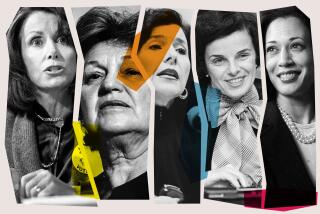Idealism’s next generation
My youngest daughter came home this weekend for the first time since the nerve-wracking start of her sophomore year two months ago, when class shortages at San Francisco State had her scrambling to land the courses she needed.
That frustrating drill was going on up and down the state back then as education funding cuts required Cal State and University of California campuses to shrink course offerings and pack classes, forcing some students to drop out and others to delay graduation.
My daughter managed to enroll in four courses, enough for the full-time status needed to qualify for financial aid and remain on her mother’s health insurance. She was disappointed; she wanted three more units. But the free time turned out to be an unexpected blessing, she said.
“I got a chance to join some clubs,” she told me, as she unpacked her weekend bag. I was delighted, imagining her saving the Earth, rescuing baby seals, sharing her journals and poetry. She is, after all, a creative-writing major whose VW is plastered with slogans such as “Live simply so that others may simply live” and “The best things in life aren’t things.”
So what’s her favorite campus club? SUP. Student Unity & Power, described on its Facebook page as “a radically-minded organization of students dedicated to building a militant movement for liberating education.”
Education SUP-style “should be about the self-actualization of people, rather than subordination to the world of business and profit,” its mission statement says. Among the ideas discussed at one of its meetings, according to the campus newspaper, was shutting down the Golden Gate Bridge to draw attention to campus cutbacks.
It sounds like my peace-loving daughter has been radicalized by budget cuts. Now if only she and her militant comrades could ignite their classmates, harness that outrage and turn it into political power.
*
A poll this month by Harvard University’s Institute of Politics proves discouraging: Only 27% of 18- to 29-year-olds said they are certain to vote in next week’s mid-term elections, a 30-point drop from the 57% who voted for president in 2008.
The survey concludes that three years of lost jobs, spilled oil, dead troops and partisan feuds have left once-enthusiastic young voters “so discouraged with politics that they may sit this one out.”
Online, young voters seem disillusioned with the president they helped elect — disappointed that the Pentagon’s “don’t ask, don’t tell” policy on gays in the military still stands; impatient with the pace of economic change; abandoned by the leadership team that once courted them.
The presidential campaign was a heady time, the first time many had cast a ballot. They knocked on doors, made phone calls, flexed new muscles. They staked their hearts to a leader who spoke their language, liked their music, knew his way around their social networks. He made them believe we were on the verge of something big, with all that “hopey-changey” stuff.
But real change is real work and sometimes takes real long. Facebook might be good for getting folks out to a rally or party, but it’s not enough to sustain the kind of energy and commitment that political organizing requires. And it’s not surprising that interest is flagging.
It must be hard for young people in California to get excited this time around, when legalizing marijuana looks like a lost cause, deciphering the propositions is a long, dull slog, and the choice at the top of the ticket is between an oddball politician your grandpa’s age and a matronly billionaire who hasn’t cast a ballot herself since before you were born.
*
My daughter was relegated to the sidelines, one month shy of 18, during the Obama phenomenon. She’s trying to make up for it this time around, studying voter guides like she’s cramming for a mid-term exam.
She’s bothered by the lethargy she sees on campus: the paltry turnout at student rallies, the classmates who didn’t bother to register until the professor threatened to dock their grades, the way everybody knows about Proposition 19, the state initiative to legalize marijuana, but no one talks about Proposition G, the San Francisco measure that would rein in pay raises for Muni drivers.
To her, they are the nice folks behind the wheel of buses that ferry her back and forth to campus — hard-working middle-aged men and women trying to buy homes and send their own kids to college. It is mean and unfair, she said, to target “the working class” with pay cuts.
She doesn’t know that public employees are considered the new “fat cats,” with powerful unions and generous pensions. She doesn’t believe that their salaries are strangling the cash-strapped transit system. And she can’t imagine that her mother — were I there—might actually side with voters “against” the workers in this one.
It’s the same sort of generational divide that led us to lock horns over illegal immigration before she left for school last summer. I bemoaned its societal costs: lowered wages, crowded schools, strained social services. She saw decent people dealt a bad hand, who deserved a chance to work their way into our country.
I’ve always been the liberal, ready to welcome her into the fold. Now am I jaded, or is she naive? We still share the same principles, but we see the details differently.
I listen as she rambles on, about revolution and oppression and injustice. And it all begins to sound familiar to me, harkening back to my own days on campus and the rhetoric of our militancy.
They are starting at a point we couldn’t have imagined in the 1970s. And we were building on our parents’ campaigns for voting rights, political power, integrated businesses, schools and society.
I can call my daughter an idealist now, as she tries to undo budget cuts with a public standoff on a bridge. But I know the power of a ballot and a dream. And Student Unity & Power sounds like a wonderful formula to me.
More to Read
Sign up for Essential California
The most important California stories and recommendations in your inbox every morning.
You may occasionally receive promotional content from the Los Angeles Times.










